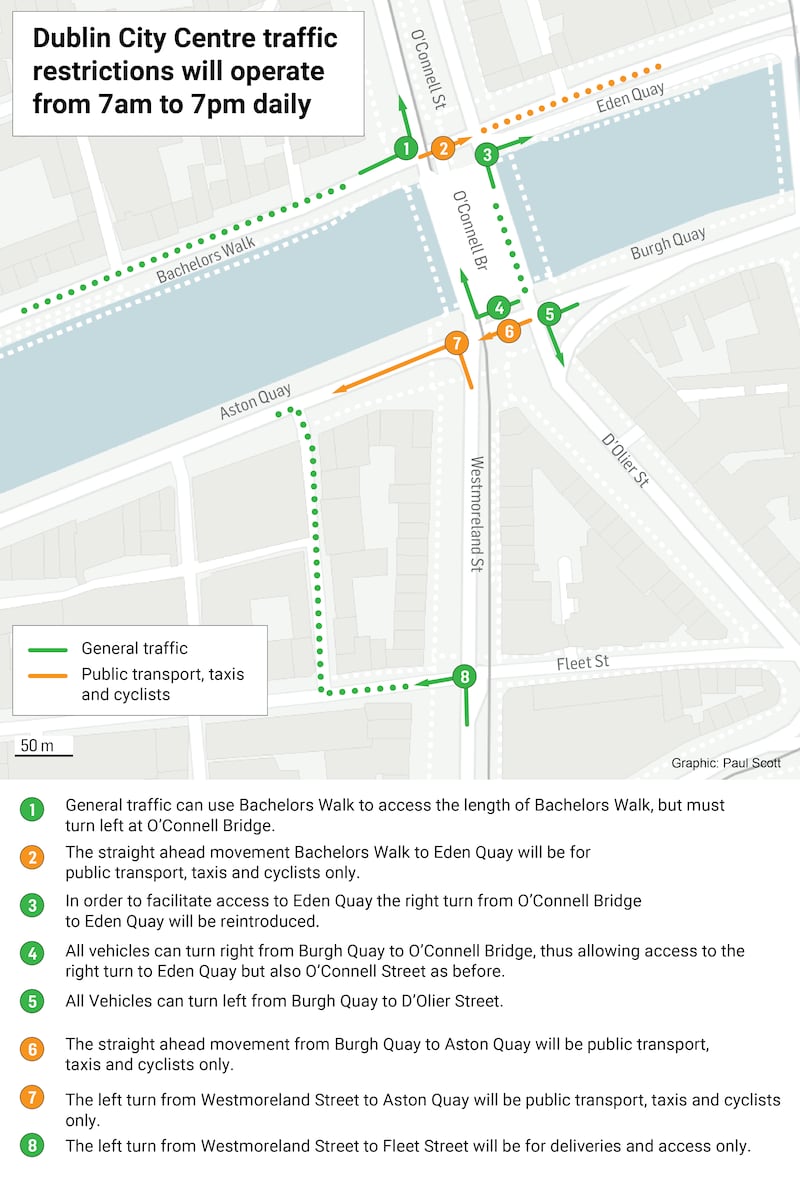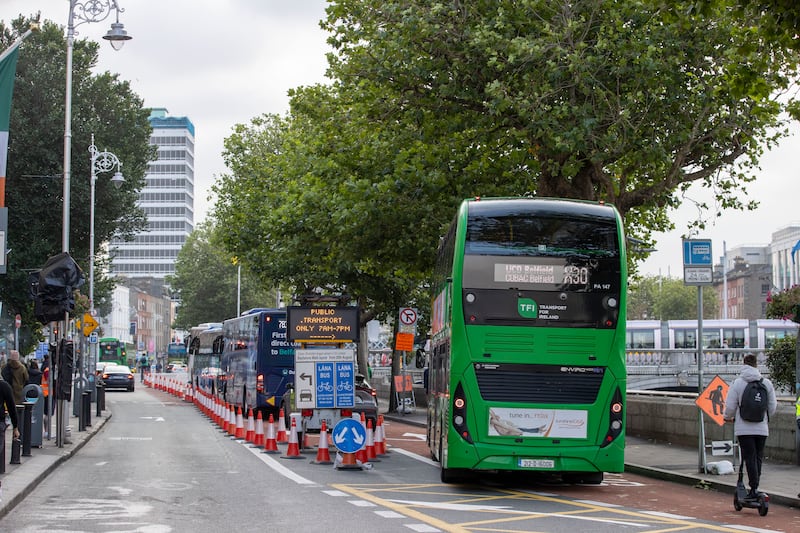Large illuminated traffic signs stretching the length of Dublin’s Liffey quays, city council workers dressed head to toe in high visibility clothing, and bright orange-surfaced bus lanes were not enough for some Monday morning motorists to get the message that new traffic rules were in place in Dublin city centre.
Since Sunday private cars and commercial vehicles are prohibited from travelling directly east or west along the Liffey at either side of O’Connell Bridge from 7am-7pm daily.
On the north quays, cars and commercial vehicles on Bachelors Walk have to turn left on to O’Connell Street and cannot go straight ahead on to Eden Quay towards Dublin Port. Private traffic is already banned from turning right from Bachelors Walk on to O’Connell Bridge to head to the south of the city.
On the south side, motorists are not permitted to drive straight from Burgh Quay to Aston Quay. The left turn from Westmoreland Street to Aston Quay is also restricted to public transport and cyclists only.
READ MORE

Drivers on the southside will still be able to cross O’Connell Bridge either by turning right from Burgh Quay, or continuing straight from Westmoreland Street to O’Connell Street. In a new concession, motorists will also be able to turn right from O’Connell Bridge on to Eden Quay, a manoeuvre which had been reserved for public transport.

To access Temple Bar from the south quays, drivers will turn left into D’Olier Street, right into College Street, in front of Doyle’s pub, and right again on to Westmoreland Street, to access the left turn into Fleet Street. This facilitates access to the Fleet Street car park, and some private car parking spaces in Temple Bar as well as business deliveries.
The restrictions will be in place from 7am-7pm daily, but even during their hours of operation, all of the north quays remains open to private traffic, and just a 50m section of Aston Quay, a stretch of three buildings closest to O’Connell Bridge, will be inaccessible to cars.
In addition, all of the city’s car parks remain accessible, and motorists will still be able to cross any Liffey bridge currently open to cars.
Traffic was exceptionally light on the quays on Monday morning, which may be down to lower commuting volumes in August, but could also be a result of the council’s messaging and signage, Brendan O’Brien head of traffic with the council said.
“It’s clear a lot of people have taken note of the advanced signage we’ve put up and have thought about how they will travel through this area. The public transport is moving really well, a lot of buses coming along through the bridge, and a lot of pedestrians and a lot of cyclists.”
There were still, many drivers of cars and commercial vehicles who would not take the compulsory left turn on to O’Connell Street from Bachelors Walk and drove straight ahead to Eden Quay. Similarly on the south side, some drivers continued straight on to Aston Quay.
However the situation was considerably improved from Sunday when, during a two-hour period in the midafternoon there was barely a cycle of traffic lights where motorists did not break the rules.

“With any kind of change it takes a while to bed down. Some people may say they didn’t realise, no matter how much signage we put up,” Mr O’Brien said. “We will monitor it over the next while, and we will be meeting the Garda to discuss compliance and what might need to be done.
“But for now, the vast majority of people are obeying it, and it’s obvious a lot of people have looked at taking alternative routing, which is a lot of what we were trying to do.”
Minister of State for Transport James Lawless said the city centre plan had his full support and should have been implemented years ago.
“This is aimed at people who are not going to the city centre, but are going through the city centre to get to somewhere else. For decades we’ve been taking that through traffic out of our local towns, why should our city centre be any different? Naas was bypassed in 1983, we’re doing Dublin city centre in 2024, why did it take so long?”
- Sign up for push alerts and have the best news, analysis and comment delivered directly to your phone
- Join The Irish Times on WhatsApp and stay up to date
- Listen to our Inside Politics podcast for the best political chat and analysis










